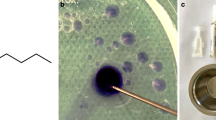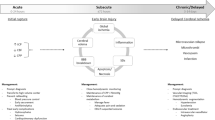Abstract
Purpose
The optimal strategy for the treatment of M1 segment aneurysms has not yet been determined as both standard microneurosurgical and endovascular techniques can pose challenges. We sought to determine the efficacy of flow diverting stents to treat small, unruptured aneurysms of the M1 segment.
Methods
We retrospectively reviewed our database of prospectively collected information for all patients treated with flow diversion for an unruptured saccular aneurysm of the middle cerebral artery (MCA) between February 2009 and February 2016. The relationship to early cortical branches, aneurysm fundus size, number and type of flow diverting stent (FDS), complications and follow-up data were recorded.
Results
In total 15 patients were identified that matched our inclusion criteria (11 female and 4 male). The average age of the patients was 58.3 years (range 14–76 years). All patients had a single aneurysm affecting the M1 segment of the MCA, 10 (66.6%) of which were related to early cortical branches and 10 aneurysms were located on the left (66.6%). The average aneurysm fundus size was 3 mm (range 2–9 mm) and 13 patients had follow-up angiographic studies. In total, 8 aneurysms were completely excluded, and 6 remained incompletely occluded (3 modified Raymond-Roy classification [mRRC] II and 3 mRRC IIIa). One patient suffered a stroke and another patient had an iatrogenic vessel dissection that was not flow limiting.
Conclusion
Flow diversion can be used to treat small, unruptured aneurysms of the M1 segment of the MCA and even though side vessel occlusion can occur clinically relevant infarction occurs infrequently.




Similar content being viewed by others
References
Lasjaunias P, Berenstein A, terBrugge KG. Surgical Neuroangiography. New York: Springer Verlag; 1987.
Brisman JL, Song JK, Newell DW. Cerebral aneurysms. N Engl J Med. 2006;355:928–39.
Rinne J, Hernesniemi J, Niskanen M, Vapalahti M. Analysis of 561 patients with 690 middle cerebral artery aneurysms: Anatomic and clinical features as correlated to management outcome. Neurosurgery. 1996;38:2–11.
Mascitelli JR, Moyle H, Oermann EK, Polykarpou MF, Patel AA, Doshi AH, Gologorsky Y, Bederson JB, Patel AB. An update to the Raymond-Roy Occlusion Classification of intracranial aneurysms treated with coil embolization. J Neurointerv Surg. 2015;7:496–502.
Dashti R, Rinne J, Hernesniemi J, Niemelä M, Kivipelto L, Lehecka M, Karatas A, Avci E, Ishii K, Shen H, Peláez JG, Albayrak BS, Ronkainen A, Koivisto T, Jääskeläinen JE. Microneurosurgical management of proximal middle cerebral artery aneurysms. Surg Neurol. 2007;67:6–14.
Ha SK, Lim DJ, Kang SH, Kim SH, Park JY, Chung YG. Analysis of multiple factors affecting surgical outcomes of proximal middle cerebral artery aneurysms. Clin Neurol Neurosurg. 2011;113:362–7.
Türe U, Yaşargil MG, Al-Mefty O, Yaşargil DC. Arteries of the insula. J Neurosurg. 2000;92:676–87.
Ulm AJ, Fautheree GL, Tanriover N, Russo A, Albanese E, Rhoton AL Jr, Mericle RA, Lewis SB. Microsurgical and angiographic anatomy of middle cerebral artery aneurysms: Prevalence and significance of early branch aneurysms. Neurosurgery. 2008;62:ONS344–52.
Topcuoglu OM, Akgul E, Daglioglu E, Topcuoglu ED, Peker A, Akmangit I, Belen D, Arat A. Flow diversion in middle cerebral artery aneurysms: Is it really an all-purpose treatment? World Neurosurg. 2016;87:317–27.
Doerfler A, Wanke I, Goericke SL, Wiedemayer H, Engelhorn T, Gizewski ER, Stolke D, Forsting M. Endovascular treatment of middle cerebral artery aneurysms with electrolytically detachable coils. AJNR Am J Neuroradiol. 2006;27:513–20.
King JT, Berlin JA, Flamm ES. Morbidity and mortality from elective surgery for asymptomatic, unruptured, intracranial aneurysms: a meta-analysis. J Neurosurg. 1994;81:837–42.
Zhou Y, Yang PF, Fang YB, Xu Y, Hong B, Zhao WY, Li Q, Zhao R, Huang QH, Liu JM. Endovascular treatment for saccular aneurysms of the proximal (M1) segment of the middle cerebral artery. Acta Neurochir (Wien). 2012;154:1835–43.
Yavuz K, Geyik S, Saatci I, Cekirge HS. Endovascular treatment of middle cerebral artery aneurysms with flow modification with the use of the pipeline embolization device. AJNR Am J Neuroradiol. 2014;35:529–35.
Neki H, Caroff J, Jittapiromsak P, Benachour N, Mihalea C, Ikka L, Moret J, Spelle L. Patency of the anterior choroidal artery covered with a flow-diverter stent. J Neurosurg. 2015;123:1540–5.
Nelson PK, Lylyk P, Szikora I, Wetzel SG, Wanke I, Fiorella D. The pipeline embolization device for the intracranial treatment of aneurysms trial. AJNR Am J Neuroradiol. 2011;32:34–40.
Brinjikji W, Lanzino G, Cloft HJ, Siddiqui AH, Boccardi E, Cekirge S, Fiorella D, Hanel R, Jabbour P, Levy E, Lopes D, Lylyk P, Szikora I, Kallmes DF. Risk factors for Ischemic complications following pipeline embolization device treatment of Intracranial aneurysms: Results from the IntrePED study. AJNR Am J Neuroradiol. 2016;37:1673-8.
Zanaty M, Chalouhi N, Tjoumakaris SI, Gonzalez LF, Rosenwasser R, Jabbour P. Flow diversion for complex middle cerebral artery aneurysms. Neuroradiology. 2014;56:381–7.
Gawlitza M, Januel A‑C, Tall P, Bonneville F, Cognard C. Flow diversion treatment of complex bifurcation aneurysms beyond the circle of Willis: A single-center series with special emphasis on covered cortical branches and perforating arteries. J Neurointerv Surg. 2016;8:481–7.
Lv X, Yang H, Liu P, Li Y. Flow-diverter devices in the treatment of intracranial aneurysms: A meta-analysis and systematic review. Neuroradiol J. 2016;29:66–71.
Wiebers DO, Whisnant JP, Huston J 3rd, Meissner I, Brown RD Jr, Piepgras DG, Forbes GS, Thielen K, Nichols D, O’Fallon WM, Peacock J, Jaeger L, Kassell NF, Kongable-Beckman GL, Torner JC; International Study of Unruptured Intracranial Aneurysms Investigators. Unruptured intracranial aneurysms: natural history, clinical outcome, and risks of surgical and endovascular treatment. Lancet. 2003;362:103–10.
Elsharkawy A, Lehečka M, Niemelä M, Kivelev J, Billon-Grand R, Lehto H, Kivisaari R, Hernesniemi J. Anatomic risk factors for middle cerebral artery aneurysm rupture: Computed tomography angiography study of 1009 consecutive patients. Neurosurgery. 2013;73:825–37.
Forget TR Jr, Benitez R, Veznedaroglu E, Sharan A, Mitchell W, Silva M, Rosenwasser RH. A review of size and location of ruptured intracranial aneurysms. Neurosurgery. 2001;49:1322–5.
Bansal H, Chaudhary A, Chhina R, Singh A, Kundra S, Saggar K. Risk of rupture of small anterior circulation aneurysms: An institutional experience. Indian J Neurosurg. 2015;04:132–5.
Murayama Y, Takao H, Ishibashi T, Saguchi T, Ebara M, Yuki I, Arakawa H, Irie K, Urashima M, Risk analysis of Unruptured Intracranial aneurysms: Prospective 10-year cohort study. Stroke. 2016;47:365–71.
Ramachandran M, Retarekar R, Raghavan ML, Berkowitz B, Dickerhoff B, Correa T, Lin S, Johnson K, Hasan D, Ogilvy C, Rosenwasser R, Torner J, Bogason E, Stapleton CJ, Harbaugh RE. Assessment of image-derived risk factors for natural course of unruptured cerebral aneurysms. J Neurosurg. 2016;124:288–95.
Żyłkowski J, Kunert P, Jaworski M, Rosiak G, Marchel A, Rowiński O. Changes of size and shape of small, unruptured intracranial aneurysms in repeated computed tomography angiography studies. Wideochir Inne Tech Maloinwazyjne. 2015;10:178–88.
Chalouhi N, Dumont AS, Randazzo C, Tjoumakaris S, Gonzalez LF, Rosenwasser R, Jabbour P. Management of incidentally discovered intracranial vascular abnormalities. Neurosurg Focus. 2011;31:E1.
Briganti F, Delehaye L, Leone G, et al. Flow diverter device for the treatment of small middle cerebral artery aneurysms. J Neurointerventional Surg 2016;8:287–94.
Author information
Authors and Affiliations
Corresponding author
Ethics declarations
Conflict of interest
M. Aguilar, P. Bhogal and R. Martinez serve as proctors and consultants for phenox GmbH, with moderate financial compensation. H. Henkes is a co-founder and shareholder of phenox GmbH. O. Gansladt and H. Bäzner declare that they have no competing interests.
All studies on humans described in the present article were carried out in accordance with national law and the Helsinki Declaration of 1964 (in its present revised form). Ethics committee approval was not necessary. Informed consent was obtained from all patients included in the studies.
Rights and permissions
About this article
Cite this article
Bhogal, P., Martinez, R., Gansladt, O. et al. Management of Unruptured Saccular Aneurysms of the M1 Segment with Flow Diversion. Clin Neuroradiol 28, 209–216 (2018). https://doi.org/10.1007/s00062-016-0553-9
Received:
Accepted:
Published:
Issue Date:
DOI: https://doi.org/10.1007/s00062-016-0553-9




